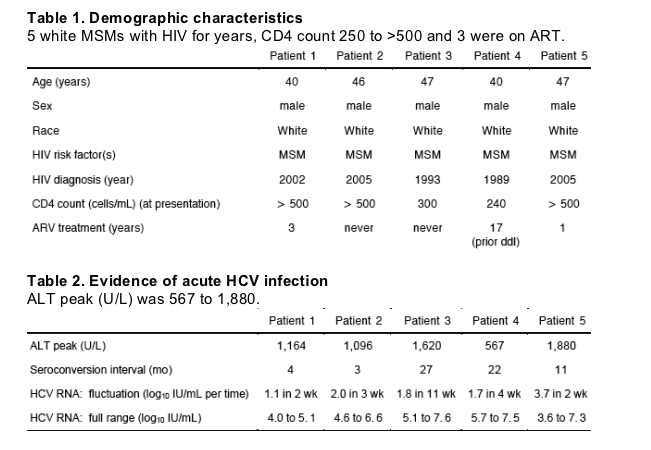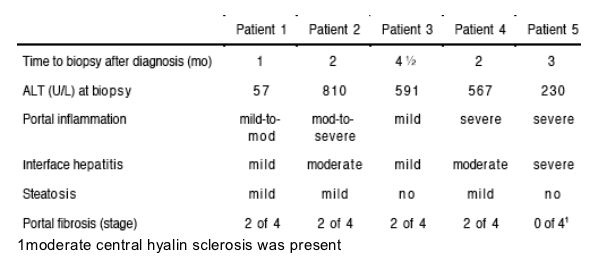 |
 |
 |
| |
In NYC: Liver Fibrosis During Acute HCV Infection of HIV-infected Men
|
| |
| |
"....HCV is just not on the radar of MSM who are not IDU..... These cases suggest that HIV-infected patients presenting with acute HCV infection may already have significant liver fibrosis..."
Reported by Jules Levin
CROI, Feb 2007, Los Angeles
Daniel S. Fierer,1 Alison J. Uriel,1 Damaris C. Carriero,1 Arielle Klepper,1 Douglas T. Dieterich,1 Michael P. Mullen,1 Swan N. Thung,2 M. Isabel Fiel,2 and Andrea D. Branch1
Departments of 1Medicine and 2Pathology, Mount Sinai School of Medicine, New York
"....Four of five HIV-infected men had moderately advanced portal fibrosis during the acute phase of HCV infection. No other etiologies were found to explain this fibrosis, suggesting that preexisting HIV infection results in accelerated fibrosis in patients with acute HCV infection. Further research is needed to define the prevalence and to understand the pathogenesis of rapid fibrosis in this population. Due to this unexpected fibrosis, we suggest that liver biopsy should be considered in these patients....." A popular pastime now is slamming [injecting] crystal meth. This can be a way to acquire acute HCV if injection syringes are shared. As well, unprotected anal intercourse, multiple sex partners, and the presence of sexually transmitted infections like syphilis or Chlamydia can increase the risk for transmission of HCV.....
".....What is being describing is really a new clinical syndrome. HIV infection before HCV infection is a newly emerging clinical disease that appears to result in very rapid progression of fibrosis. These New York City patients were MSM not IDU, and we have strong laboratory evidence that these patients were acutely infected with HCV: recent seroconversion (in patients with high CD4 counts, no reason to believe prior negative Ab were false negatives), very high ALT spikes (typically over 1,000), and widely fluctuating HCV VL, a hallmark of acute infection. Further, they fit exactly in the descriptions of HIV-infected MSM with acute HCV reported by a variety of European groups and the one from UCSF. The difference between the NYC patients and those in Europe is that four of five had a possible recent (new) percutaneous (injection) exposure (they are not IDU but had recently experimented with 'slamming' [injecting] crystal); all had significant possible sexual exposures as well. [The authors say] -- Our findings of moderate HCV fibrosis are extremely worrisome, advanced liver disease within only one month of (asymptomatic) presentation of hepatitis, but even more so in the context of an older paper from the NIH. In 1989, the NIH group published in Gastro a report of three 60 yo men with HIV infection who developed decompensated cirrhosis within three years of the transfusion that transmitted non-A, non-B hepatitis (pre-HCV Ab testing days). Our study demonstrates that this liver disease begins immediately and that the NIH patients were not fluke findings on the extreme end of the "usual" clinical course of HCV...
....Multiple outbreaks of acute hepatitis C virus (HCV) infection have recently
been reported in Europe and San Francisco among human immunodeficiency
virus type 1 (HIV)-infected men-who-have-sex-with-men (MSM). These
outbreaks were notable because the patients were already HIV-infected when
they acquired HCV, unlike most patients with both HIV and HCV infection,
who typically acquired HCV prior to HIV. Although much is known about the
course of liver injury in HCV-infected patients who later acquire HIV, nothing
is known about the course of liver injury in HIV-infected patients who later
acquire HCV. We established a prospective study of HIV-infected MSM with
acute HCV infection, including examination of liver histology, and report the
findings from the first five consecutively-enrolled patients....
....The main clinical message is that liver disease is already present during the acute phase of infection. These findings demonstrate the necessity of identifying ALL cases of acute HCV in HIV-infected men in the acute phase, while they still have a higher chance of cure (about 75% vs half that at best during the chronic phase). The implications of missing them are dire, the possibility of advanced liver disease/cirrhosis within just a few years, and with the incredibly poor response rate to IFN/RBV treatment to stem the disease at that point. In 5 years following this outbreak of acute HCV we may be seeing an outbreak of cirrhosis in otherwise healthy HIV-infected men...."
To this end, to identify these men, this group at Mt Sinai has begun to establish a New York Acute HCV Surveillance Network. This Surveillance Network is comprised of providers who specialize in care for MSM in the NY metro area (mostly in private practices); they have a half-dozen or so providers who have referred patients so far. Participation in the Surveillance Network is a simple process: use basic uniform laboratory screening [LFTs at least every 3 months, HCV Ab at least every year, and LFTs and Ab and consider VL testing when evaluating/following any STI or change in risk behavior], and refer patients to the Mt Sinai group at the first detection of ALT spike (preferably not waiting for subsequent testing to return). To not miss any HIV+ men who are currently in care, they would like to involve practitioners in the area, to protect the health of these men.
ABSTRACT
Multiple outbreaks of acute HCV infection have recently been reported in HIV-infected men-who-have-sex-with-men (MSM). The extent
of liver disease in these patients is unknown and is of concern.
Five consecutive HIV-infected MSM referred to Mount Sinai for
the treatment of acute HCV infection were enrolled in a prospective study of
acute HCV infection after providing informed consent.
Results:
All five had acute HCV infection confirmed using the following
criteria: ALT elevations of >10 x ULN, HCV antibody seroconversion, and
widely fluctuating HCV VL, and all had clinical and laboratory findings
consistent with previously reported cases of acute HCV in HIV+ MSM.
Liver biopsy performed within 4.5 months of elevated ALT levels,
surprisingly, showed moderate portal fibrosis (stage 2 of 4; Scheuer) in four
of the five patients, as well as the expected findings of acute viral hepatitis in
all patients; moderate central hyalin sclerosis was found in patient 5.
All patients had negative evaluations for HAV and HBV, all denied heavy
alcohol use, and two had never received antiretroviral treatment. No cause
of liver disease common to all patients, outside of HCV infection, could be
identified to explain the fibrosis.
Conclusions: Four of five HIV-infected MSM had moderately advanced
hepatic fibrosis found on liver biopsy during the acute phase of HCV
infection. These cases suggest that HIV-infected patients presenting with
acute HCV infection may already have significant liver fibrosis, and liver
biopsy should therefore be considered in these patients.
No evidence for other etiologies of new hepatitis was found. All patients had recent histories of unprotected receptive anal intercourse (URAI), some with many partners; three acknowledged a single recent episode of injection drug use (IDU) but without clear recollection of paraphernalia sharing; one shared snorting paraphernalia; and all denied any other risk factors for HCV infection.
Acute HCV infection
Defined as the first six months of an HCV infection. Because no single test result provides a definitive diagnosis of acute HCV infection, we considered three factors in combination:
1. recent seroconversion to HCV antibody positivity
2. marked elevations in serum ALT levels; and
3. wide fluctuations in HCV viral load
The latter two are considered to be hallmarks of acute HCV infection and are rare during chronic infection.
All patients were MSM in their 40s (Table 1) who had:
·recent seroconversion to anti-HCV antibody positivity, in three cases within a year after
negative tests, defining a very narrow time window in which the new HCV infection
could have occurred;
1. rapid changes in ALT levels with elevations greater than 10-fold over the upper limit of
normal (ULN), consistent with acute hepatitis;
2. wide HCV viral load fluctuations, in four cases exceeding 1.5 log10 IU/mL (Table 2
and Figure 1). Liver biopsies were performed within 4-5 months of the first-noted elevation in ALT levels
-- All had negative evaluations for active HAV or HBV infection

Table 3. Liver Histology Findings
ALT at biopsy was over 230 in 4/5 patients and 560 to 800 in 3. Portal inflammation was severe in 2, mild to moderate in 1, mild in 1, and moderate to severe in 1. 3 had mild steatosis. And 4/5 had stage 2 of 4 portal fibrosis.
Liver histology
During the acute phase of HCV infection, four of five HIV-infected men had portal or periportal fibrosis characteristic of stage 2 (of 4) fibrosis of chronic HCV infection, a highly unexpected finding. All biopsies showed, in addition, features typical of acute viral hepatitis, such as diffuse necroinflammatory changes in the lobules and portal inflammation, further confirming that the biopsies were obtained during the acute phase of HCV infection (Figure 2, Table 3). Immunostains for HBsAg and HBcAg were negative in all patients (not shown).
The biopsy of patient 5 showed moderate central hyalin sclerosis but no increase in portal fibrosis.

|
| |
|
 |
 |
|
|